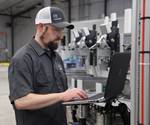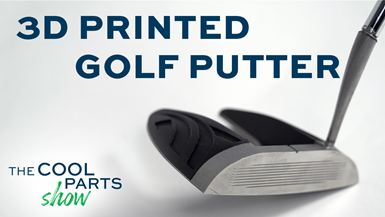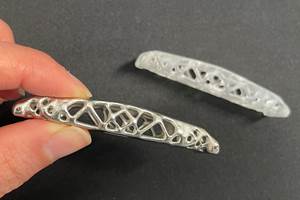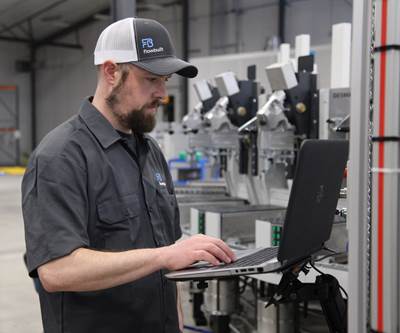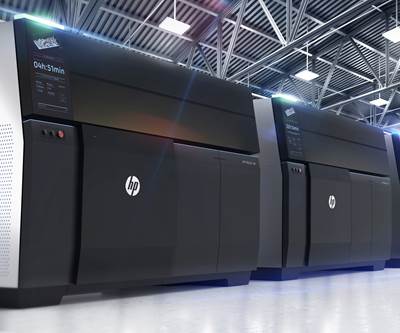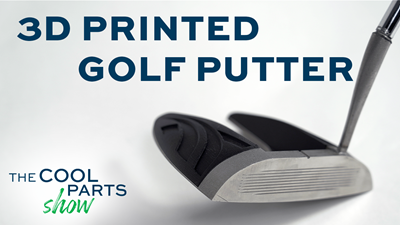A golf club is a deceptively simple object. Each club is really just three parts: a head, a shaft and a grip. But to build just the metal clubhead alone requires no less than 200 human touches, says Mike Yagley, vice president of innovation/AI at Cobra Golf.
Investment casting and forging are the two primary ways of making golf club heads; Cobra is also advancing the use of metal injection molding (MIM) for building these components. But in all cases, these are preliminary steps; the near-net shape metal forms must then be further processed.
“You’ve got to grind and polish and finish and cut grooves,” Yagley says. “There’s machining. There’s handwork. It could need PVD [physical vapor deposition] or chrome. You have to add medallions to make it look pretty, and maybe some weight pieces. If you’ve got little engravings, you paint fill. It’s a very labor-intensive process.”
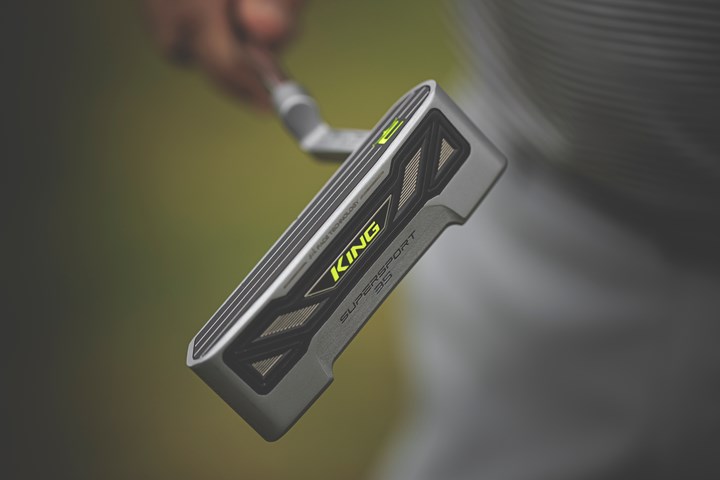
A golf club is essentially just three parts: the head, the shaft and the grip. But the head alone can require up to 200 steps to manufacture between casting or forging, machining, assembly and finishing touches. Photo Credit: Cobra Golf
When Cobra introduced the King Supersport-35, a putter with 3D printed head developed with Parmatech and HP, in November 2020, much of the buzz was about the design. With its open lattice framework and extremely high moment of inertia (MOI; a measure of weight distribution that affects twist), the club both looks and feels different than conventional putters. Golf publications, review vloggers, pros and amateurs alike weighed in on the sound of the head, the way it feels to hit a ball with this putter, and their personal track records of success or failure with the club.
But the design was only one half of the challenge in producing the King Supersport-35. As Yagley puts it, “We were developing a product and process at the same time.” For more than a year, his San Diego-based Cobra innovation team closely collaborated with both HP’s Metal Jet group and contract manufacturer Parmatech to develop the putter design while also proving out the technology. Their efforts have resulted in the first commercially available 3D printed putter on the market, but will bring new manufacturing options to future endeavors.
50+ Design Iterations in 12 Months
Cobra Golf was founded in 1973 and since 2010 has been owned by Puma, a supplier of sportswear and accessories such as athletic shoes and apparel. Puma Golf already had a standing relationship with HP’s polymer 3D printing facility in Southern California, having leveraged its Multi Jet Fusion (MJF) printing process to make plastic prototypes. This arrangement eventually led to Cobra’s introduction to the Metal Jet team at HP, and through them, contract manufacturer Parmatech. (The latter was one of the earliest partners for Metal Jet, a binder jetting 3D printing technique which applies binding agents to metal powder to form green parts. These are then sintered to their final forms, losing about 20% of their size in the process.)
The idea of making a putter through Metal Jet 3D printing was appealing on both sides. For HP and Parmatech, the project was an opportunity to develop a Metal Jet process on a part with lower stakes than an aerospace or automotive component, for example. For its part, Cobra was interested in creating a unique, innovative club design that couldn’t be made through conventional technologies — something that could give golfers an experience not possible with any other club.
On top of the benefits to the golfer, though, Yagley and his team saw another opportunity in finding an alternative means of manufacturing the near-net metal shapes of club heads, which are generally made outside the U.S. Cobra specifically sources metal parts from casting and forging houses in China, Vietnam and Japan. Other parts of the clubs might be made in other parts of the world, such as grips manufactured in Mexico.
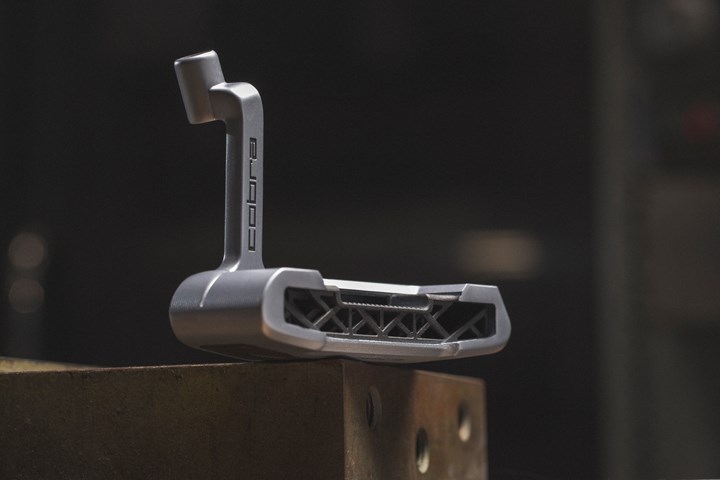
For the Cobra King Supersport-35, Metal Jet 3D printing was a means of achieving a unique clubhead geometry but also something more than that. In this case, a local 3D printing process took the place of casting or forging overseas, effectively reshoring manufacturing for this component. Photo Credit: Cobra Golf
Obtaining parts from suppliers abroad is generally cost effective, but the distance and reliance on conventional, tooled manufacturing processes can add significant lead time to product development. It can take up to 3 months to create a single design iteration for a new club working with overseas suppliers, Yagley says. Moving the product can also be a challenge; air shipping is faster, but costs significantly more than transporting goods via boat.
The 3D printed putter head avoided most of these challenges. Parmatech is located in northern California, putting it in the same state as Cobra’s development and assembly facility in the San Diego area, which allowed for in-person meetings and collaboration that simplified the product development process. Additionally, the speed, lack of tooling and batched nature of Metal Jet 3D printing which make it suitable for production also allowed for rapid iteration, sometimes with multiple designs printed at once in the same machine. Engineers on the Cobra innovation team, most of whom are golfers themselves, were able to have prototypes made and delivered quickly for testing and refinement.
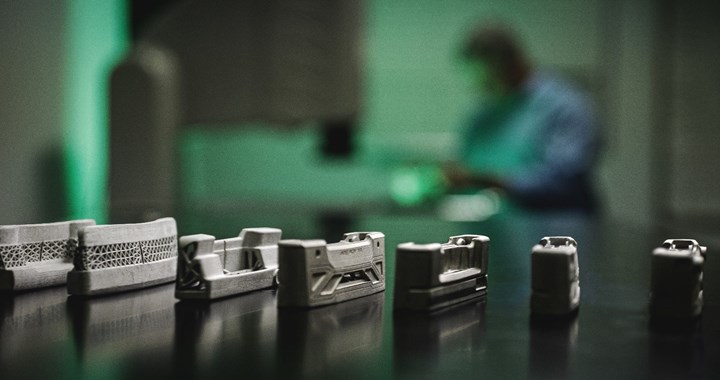
Just a handful of the 56 different design iterations Cobra explored before landing on one. Without 3D printing, so many design changes would have been prohibitively expensive and time-consuming. Photo Credit: Cobra Golf
“We went through 56 different versions of the final design within 12 months,” Yagley says. “If we were to do that many iterations in a conventional casting or forging or machining process, that would be years and years of work.” Once the desired design was selected, the teams spent time refining it to improve both printability and performance. The production club heads were also made at Parmatech, effectively reshoring manufacturing for these items.
Metal 3D Printing Plus Conventional Postprocessing
The final design for the King Supersport-35 combines new and old elements, for an experience that is both novel and familiar to the golfer. The head has a “modern traditional” rectangular shape common to many putters. Faceplates on the front of the clubhead make use of licensed technology from SIK Golf to control the loft of the hit. (This Descending Loft Technology is popular with golf pros including Bryson Dechambreau, winner of the 2020 U.S. Open and a Cobra staffer.) The front, top and bottom of the head have been machined and finished just like any other club head, with smooth surfaces, paint in-fill and other design elements that any golfer would expect.
But it was important to the stakeholders involved that this club not only utilize metal 3D printing technology, but showcase it as well. The back of the stainless steel putter head leaves its lattice structure visible; the surfaces here have been PVD coated but not polished, preserving the soft roughness characteristic of the binder jetting process. The lattice showcases the capability of the manufacturing process, but also serves a very functional purpose; the design distributes more of the head’s weight to its perimeter, increasing the club’s MOI 20% over a comparable shape made conventionally — a significant effect likely to translate to improved consistency in putting.
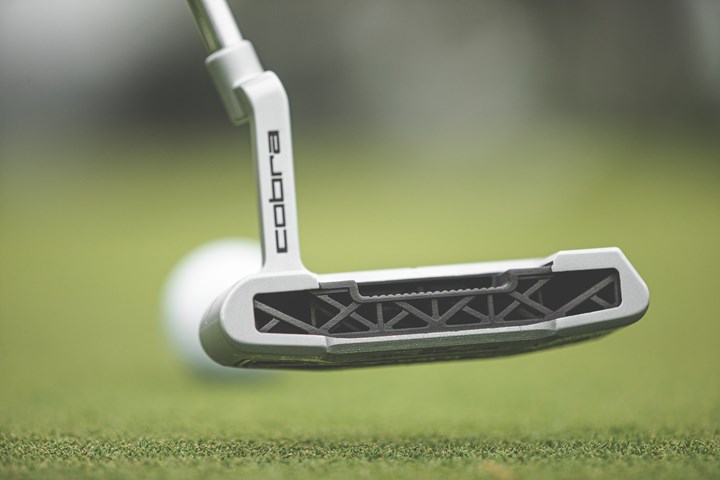
The open lattice design redistributes the weight of the putter head for better performance. A typical moment of inertia (MOI) for a putter is in the range of 2,500 to 4,000 g/cm2, Yagley says. The 3D printed putter has an MOI of about 5,000 g/cm2, a noticeable 20% increase over other clubs. Photo Credit: Cobra Golf
Aside from the standard Metal Jet requirements of de-caking, sintering and powder removal, the other postprocessing steps performed on the putter head are not strictly necessary, Yagley says. In fact they add cost to the process, but the addition is worth it for the sake of preserving some conventional aesthetics, at least for now. In a sense, this club is an ambassador for future designs, one that will help golfers get used to what a 3D printed head could look like in the future with fewer smoothed and polished surfaces.
“We’ve trained ourselves to like shiny chrome and machined things. If we did an entire club head with an as-printed surface right now, people would say, ‘I don’t know if I like the look of that’,” he says. “But as 3D printing becomes more common in the mainstream for other objects, I can envision a day where the face is the only truly finished surface.”
With Maturing Technology, Opportunities Will Expand
The King Supersport-35 became available in limited quantities on November 20, 2020, with a price tag of $399. Putters often command higher retail prices than other clubs, which made a putter the natural place to begin experimenting with a costlier metal 3D printing process. But Yagley anticipates that the costs of making club heads this way will drop, as the Metal Jet process matures; as Cobra becomes more adept at designing near-net shapes that minimize postprocessing; and as consumers become more open to clubs with as-printed surfaces.
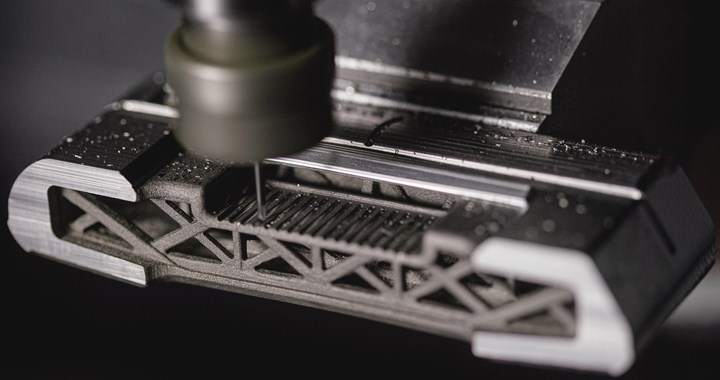
The 3D printed putter head received almost as much machining and finishing as a standard clubhead, but this may not always be the case. As consumers become more acclimated to seeing rough, unfinished 3D printed surfaces, manufacturers could save time and cost by applying these processes only where necessary. Photo Credit: Cobra Golf
In the short term, Cobra sees opportunities to apply Metal Jet for other limited run products, possibly including custom club heads. The ability to batch parts inside the printer could allow for many different design configurations to be made at once, tailored to the needs and preferences of individual golfers. Large-scale mass production is not likely just yet, as it would be difficult to produce clubs at scale for a price that consumers would be willing to pay. But over the long term, Yagley also expects a future where most or all clubheads could be made through 3D printing.
“When we started dreaming of this 10 years ago, the cost of making a single part was probably 10 times what it is now,” he says. “We’re not quite at a point where we could make a set of irons or metal woods cost effectively, but we’re getting much closer. As fast as this technology is going, it may be only a couple of years.”
3D Printed Putter Tailored to the Golfer: The Cool Parts Show #49
Where else might the idea of 3D printed golf club heads lead? Personalization is a likely possibility. Wian van Aswegen, a student at Nelson Mandela University and accomplished golfer, developed a customizable putter head design that combines both metal and polymer 3D printing. WATCH
Related Content
This Year I Have Seen a Lot of AM for the Military — What Is Going On?
Audience members have similar questions. What is the Department of Defense’s interest in making hardware via 3D printing over conventional methods? Here are three manufacturing concerns that are particular to the military.
Read MoreVulcanForms Is Forging a New Model for Large-Scale Production (and It's More Than 3D Printing)
The MIT spinout leverages proprietary high-power laser powder bed fusion alongside machining in the context of digitized, cost-effective and “maniacally focused” production.
Read MoreHow Norsk Titanium Is Scaling Up AM Production — and Employment — in New York State
New opportunities for part production via the company’s forging-like additive process are coming from the aerospace industry as well as a different sector, the semiconductor industry.
Read MorePossibilities From Electroplating 3D Printed Plastic Parts
Adding layers of nickel or copper to 3D printed polymer can impart desired properties such as electrical conductivity, EMI shielding, abrasion resistance and improved strength — approaching and even exceeding 3D printed metal, according to RePliForm.
Read MoreRead Next
Shoe Manufacturing at Flowbuilt Is Reshored and Reimagined
The shoe store of the future is more like a digitized tailor’s shop than a warehouse. Flowbuilt Manufacturing is the flexible contract manufacturer that can serve this vision, using both 3D printing and injection molding.
Read MoreHP Enters Metal Additive Manufacturing with Production-Focused Binder Jetting Machine
A metal 3D printer for scale production of steel parts is the next extension of HP's additive offerings and the logical extension of printer technology the company has been developing for decades.
Read More3D Printed Putter Tailored to the Golfer: The Cool Parts Show #49
An engineering student in South Africa used metal and polymer 3D printing in tandem to create a putter customized to the individual golfer’s swing.
Read More

.jpg;width=70;height=70;mode=crop)
